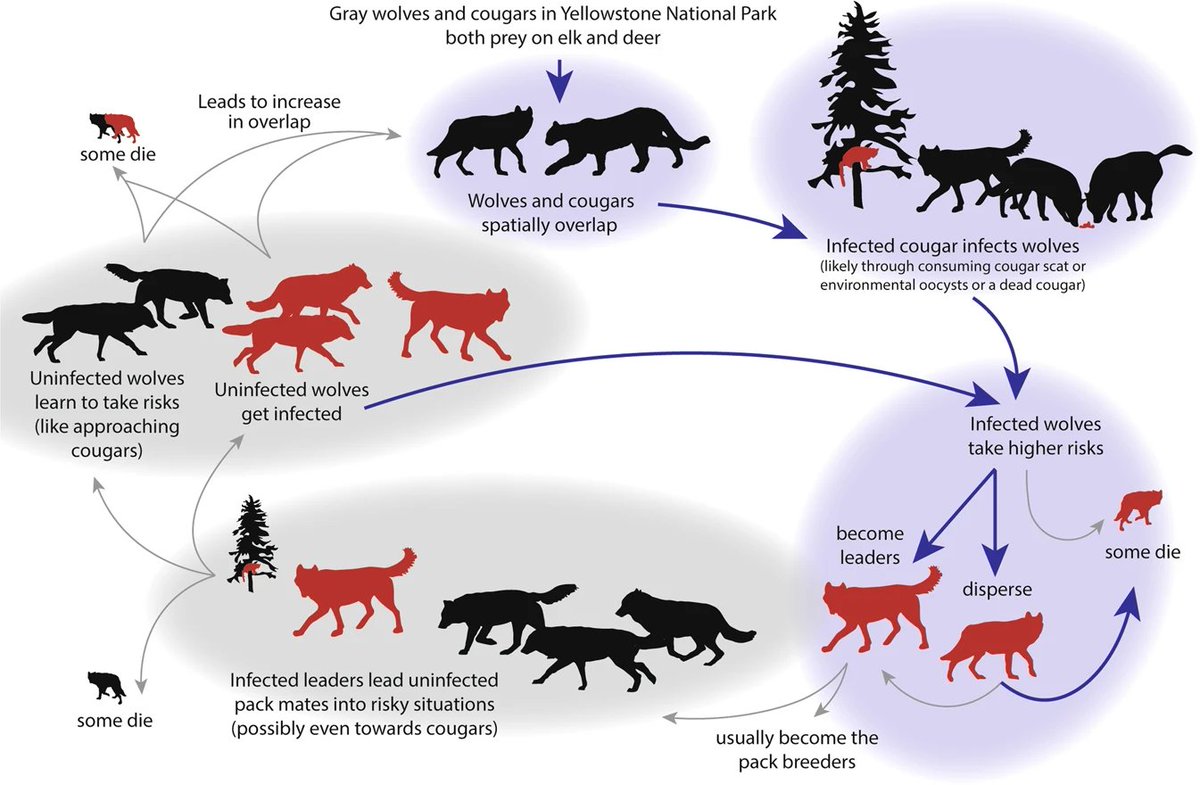
nature.com/articles/s4200…\\
A rather remarkable study. The authors propose that infection by the apicomplexan parasite Toxoplasma changes the behavior of wolves and makes them greater risk-takers, thereby increasing their tendency to break off and found their own packs or become
A rather remarkable study. The authors propose that infection by the apicomplexan parasite Toxoplasma changes the behavior of wolves and makes them greater risk-takers, thereby increasing their tendency to break off and found their own packs or become
leaders of packs. They propose that this behavior brings them in contact with pumas that the wolves normally avoid and results in increased propensity for them being infected by the parasite on one hand and increased propensity to transmit them to the cat, which is the definitive
host (where the parasite completes its sexual cycle), on the other. Thus, the parasite manipulates the behavior of the wolf, in a sense it even imparts the host with a possible positive effect on fitness, to further its own transmission. This parallels the house cat-rodent cycle
of Toxoplasma, wherein the parasite changes the neurotransmitter concentrations in the mice and rat brains to make them go towards cats. Here, it reduces the fitness of the rodent rather unequivocally while increasing its probability of transmission to the definitive host. In
domestic dogs, Toxoplasma can be sexually transmitted by males; hence, it might also similarly be transmitted within a wolf pack via sex. Toxoplasma might also make male rats more sexually active by increasing testosterone production and similarly enhance its own transmission via
the sexual mode. While humans might be in part a dead end host for it, there is some evidence it might alter the sexual behavior and aggression in both males and females -- be vary of having a cat as a pet. However, in our close cousin, the chimpanzee, Toxoplasmosis causes a
morbid attraction towards leopard urine, thus, increasing their chances of being killed and eaten by one. In a different strategy, the related parasite Sarcocystis infects the heart muscles of hare and deer and makes them slower. Thus, they are eaten by dholes and is transmitted
to them. In turn a subset of the dhole pack might carry higher levels of the parasite and play a role in transmitting Sarcocystis to herbivores via their latrines -- again a potential fitness gain (probably via kin) to the pack. 

nature.com/articles/s4146…
Another study which shows that hyena cubs infected by Toxoplasma tend to lose their fear of lions and approach them more closely than uninfected one. Thus, they tend to be killed more often by the cats and transmit the parasite to their definitive host.
Another study which shows that hyena cubs infected by Toxoplasma tend to lose their fear of lions and approach them more closely than uninfected one. Thus, they tend to be killed more often by the cats and transmit the parasite to their definitive host.
• • •
Missing some Tweet in this thread? You can try to
force a refresh





